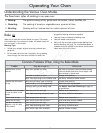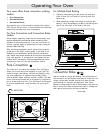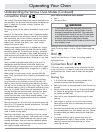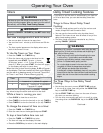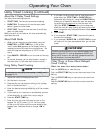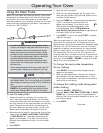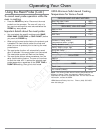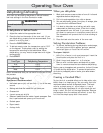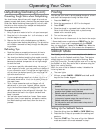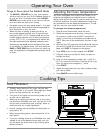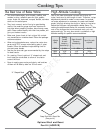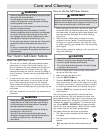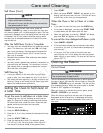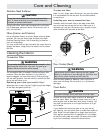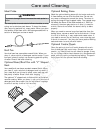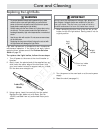
20
Operating Your Oven
Dehydrating/Defrosting (Cont.)
Preventing Tough Skins when Dehydrating
You should water blanch items with tough skins such as
grapes, prunes, dark plums, cherries, gs and some types
of berries. Water blanching these types of fruit will crack
the skins so that moisture can escape and dehydration
can be done more effectively.
To water blanch:
Bring 2 quarts of water to boil in a 4 quart sauce pot.1.
Drop the fruit in the water for 1 to 2 minutes, or until 2.
the skin begins to crack.
Remove the fruit with a slotted spoon and dab dry 3.
with a paper towel before dehydrating. The pit can be
left inside or removed half way through the dehydrat-
ing process.
Defrosting Tips
Food that takes an exceptional amount of time to •
defrost will not defrost well in a convection oven.
You should not defrost anything that would normally •
take over 2 hours to thaw. The food will begin to spoil
because the defrost temperature is not high enough
to cook the food.
If you have a partially defrosted turkey, rib roast or •
other large cut of meat, you may continue to defrost it
in your convection oven. If wing tips and legs begin to
dry out when you defrost poultry, you may wrap the
tips with aluminum foil.
If you are defrosting a small cut of meat, lay it on a •
at cookie sheet with a 1-inch rim to catch juices as
the meat thaws.
Thick, frozen casseroles such as lasagna will not •
defrost well in your oven. Instead, defrost accord-
ing to the food manufacturer’s suggestions. You can
defrost casseroles in the refrigerator overnight. You
should leave the food in its original container and
keep it covered.
You can bake some foods from frozen. Some exam-•
ples are: pizza, frozen pastries, croissants, cookies,
etc. Before baking frozen food, allow the oven to
preheat.
Proofing
You can use your oven to proof yeasted doughs at a low a
and draft-free temperature using the Bake mode.
Press the 1. BAKE key*.
Enter the temperature of 100°F on the keypad.2.
Press 3. START.
Place the dough in a greased bowl inside of the oven. 4.
Cover it with either a damp cloth or plastic wrap
coated with a nonstick spray.
Turn on the oven lights.5.
Set the timer for the amount of rise time in the recipe.6.
* Some double oven models have a PROOF key for the
lower oven. If your oven is equipped with the PROOF
key, you may press it instead of the BAKE key. When the
using the PROOF key, the oven presets the temperature.
Sabbath Mode
The Sabbath mode on your oven complies with Jewish
laws for use on the Sabbath and Holy Days. This feature
allows the oven to perform two types of cooking, Bake
and Pure Convection. The settings the oven will run during
the Sabbath or Holy Day can be set in advance using the
delay time cooking feature.
When the oven is set to Sabbath modes, it disables the
following features:
The oven lights•
All keys, except • CANCEL · SECURE and the 0 and 2
keys on the number keypad
note
“• SAb” appears on the display when Sabbath mode is in
operation.
If one or both timers are running, the oven cancels timer •
operation when Sabbath mode is selected.
Sabbath mode will not work with the meat probe connected •
(the meat probe symbol will flash.)
In the event of a power outage, the oven will return to •
Sabbath mode when power is restored.
You may want to use a rack thermometer to keep track of •
the oven temperature.
Setting Up the Sabbath Feature
Press the 1. # key then the BAKE or PURE CONV key.
Press the 2. 0 or 2 keys to pre-select the cooking tem-
perature.
Press the 3. START key. The oven will go into Sabbath
mode and cook in the mode selected in step 1.



